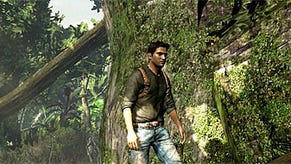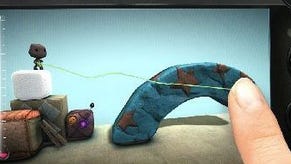A question of relevance: PlayStation Vita's the answer
With only six weeks to western launch, PS Vita must now prove a dedicated, high-end games handheld can succeed in a world of multi-faceted iFunction. Johnny Cullen gives impressions of a Japanese unit and games.
Six weeks isn't tomorrow, but it feels like only yesterday that we first saw NGP on stage in Tokyo; in fact, it was nearly a year ago. Now, Sony hopes the renamed PlayStation Vita will set the world on fire, presenting itself as the Swiss Army knife of handheld gaming.
We've debated the relevance of a specialist handheld gaming device since iPad and iPhone rolled onto the scene, and if Vita itself has a chance against 3DS.
While the argument surrounding the very existence of Vita's place in the market continues, some are already expressing doubts about the console's ability to stand up against Nintendo's machine, following sluggish sales so far in Japan.
It's too early to call it yet. From what I've seen of it, PlayStation Vita deserves to succeed.
Once you open its packaging and take it out, you'll find Vita is light, something I hadn't noticed when I tried it during gamescom last year. It's also very sleek, which is why I'm so apprehensive about putting my sticky fingers all over its gorgeous 960x544 five-inch OLED touch-screen.
Light as it may be, it's big. It's thicker than my PSP-3000, thicker than my PSP-1000, and just about the same dimensions as my 3DS, give or take.
The giant, immediate plus is the inclusion of a second analog stick. The lack of it was one of PSP's big sticking points, and it's something Nintendo is aiming to rectify on 3DS with its slider pad, meaning it's probable any 3DS redesigns will add a second stick.
The dual control is a godsend, especially for games like Uncharted. As for the rear touchpad, it doesn't show its use until we get into some of the games, like Golden Abyss, so we'll leave that for later.
You say hello, I say hello
Turning Vita on for the first time brings up the PlayStation and make.believe Sony logos, after which you peel back on the touch screen to start setting up the system. Required are language, timezone, date and time, and your PSN details, but you can set up a trial account if you wish.
After that's done, you'll get a mandatory introduction video that shows you the basics. From there, you're greeted with the new home menu, radically different from the XrossMediaBar (XMB) on PlayStation 3 or PSP. Instead, Vita comes equipped with LiveArea, a more social-focused set-up.
Instead of focusing on categories for certain kinds of media, LiveArea starts with apps such as Party, Friends, Group Messaging and Trophies.
When you're greeted on LiveArea for the first time, you're directed towards Welcome Park, an app which shows off and encourages you to adjust to some of the main functions of the console, such as the touch-screen, camera, SIXAXIS and more, through the use of mini-games.
For example, when on the SIXAXIS tutorial, you'll get a game called Skate Axis. This involves skating while using the motion controls to avoid balls, as well as tilting to jump.
For the microphone, there's Sound Loop, where you record sounds and your voice then play it back as some sort of disjointed music, or whatever you want to call it.
Welcome Park is a nice introduction to the world of features that come pack in with Vita, and should make the settling in process easy.
The Social Network
One of the strongest areas in Sony's presentations of Vita this past year has been social connectivity. It focused on it at its press conferences at gamescom, Tokyo Game Show and, to a lesser extent, at a developer session with Sony WorldWide Studios European boss Michael Denny at Eurogamer Expo.
Facebook and FourSquare have been promised, but Twitter is a launch app. LiveTweet is not available out from the box, so if you have a unit as the moment you'll need to download from the Hong Kong or Japanese PlayStation Store. Obviously, it's free.
It's your bog-standard Twitter app. You tweet, you post pictures using the system's cameras, add hashtags, select friends to mention, browse profiles and search. Anything you'd find in a standard app or programs like Tweetdeck is included.
Another key aspect to Vita's social side is Near, an application that lets you find other people nearby who have a Vita and see what games they're playing, among other things. As no one else is likely to have a Vita where I live until February 22, I'm unable to properly use it. Near's promise sounds good, though: being able to find other Vita owners in the area, seeing what they're playing and being able to leave gifts and challenges; think of this as Vita's StreetPass, but more sophisticated.
Group Messaging allows you to add friends into a group and send them a message. Simple. Next is Party; you can add a list of friends, the same as Group Messaging, but this time hang out with them in one whole group, text chat to one another or even speak to each other through voice chat. I haven't been able to try this out properly as yet, though.
You'll also have your Friends list in a separate app, where you can see what they're currently playing on either Vita or PS3. An added plus is you'll be able to compare Trophies against one another.
Even without Facebook and Foursquare, and without having the chance to properly test Near or Party, it's clear Vita's social capacities are strong, more so than Nintendo's light efforts with 3DS.
Social connectivity is vital in a world where so many people habitually use Facebook and Twitter, and Vita is well-equipped to deal with the internet landscape of today.
Remote possibilities
If anyone paid attention to Shuhei Yoshida's Tokyo Game Show keynote last September, Remote Play on Vita - besides offering control access to your PS3's media content, as did PSP - has big potential, possibly even as far as playing PS3 games.
Yoshida showed Killzone 3 streamed to the handheld using Remote Play, as well as a co-op session of LittleBigPlanet 2 on PS3, where one player used a Vita as the controller. Eurogamer rumoured last year the feature would be patched into a future Firmware update.
But for now, you just have the vanilla Remote Play familiar to PSP owners. You're still able to play PS1 games and PS3 media through your handheld, but unable to watched locked content on your PS3, such as TV shows and movies.
This time round, however, Vita has a dedicated Content Manager app that allows you to swap media content from PS3 to Vita, and likewise between PC and Vita. I tried swapping several episodes of Arrested Development, The Social Network and Tron Legacy between PS3 and Vita using Content Manager. In the end, it took about 15 minutes to finish once the swap began.
For other multimedia possibilities, music and video is music and video. Shock. I watched a few episodes of Arrested Development and The Social Network and the image quality is top notch, a lot better than PSP. I haven't tried it outside yet (mostly because it hasn't actually been sunny even once since I got it - it's been howling winds, rain and dark), so I can't comment on how the screen stands up to glare, but it's great indoors.
That, however, can't be said for the camera. While I've yet to see its use in games, the quality definitely not the greatest, as you can see in some of the photos I've taken with it below. Don't expect decent quality photography.
For its browser, Sony seems to have done a better job here than it did with PSP, although it's brain-meltingly slow. Flash doesn't work on it either, so don't expect YouTube support for at least a while yet.
Uncharted territory
But for all of the multimedia features, with all of its social functionality and all of its amazing hardware specs, at its core PlayStation Vita is a gaming handheld. Everything else comes secondary to the games. And the games I've played so far have been brilliant. When I got it, I picked up Ultimate Marvel vs Capcom 3, Everybody's Golf 6 and, of course, Uncharted: Golden Abyss.
I also tried out the Gravity Rush demo. I did a piece on that, which you can find here. Spoiler: it's awesome.
For importers, Ultimate Marvel vs Capcom 3 will come in a mix of Japanese and English, with menus in Japanese and voicework mostly in English. There's nothing that's going to shock players of the original MvC3 or those who picked up the console version of UMvC3 besides the new characters.
I'm no expert on fighting games, but I've liked what I've played of UMvC3 so far, and it adjusts well to a handheld. That sign alone might be good news for Street Fighter x Tekken's release on the system sometime this year.
I liked Everybody's Golf: World Tour when I had it on PS3, so getting back into Everybody's Golf 6, even if it was all Japanese, was easy enough. From what I've tried out so far, it feels like an Everybody's Golf game. That's no bad thing, but there's not much else to say besides that.
I gushed about how much potential Uncharted: Golden Abyss had as the killer app for PlayStation Vita back at gamescom, having spent 15-20 minutes with it at the Sony presser and some free time with it at Sony's off-site appointments. Naughty Dog's trust in putting the Uncharted series into the hands of Sony Bend has been well placed. I'm still to finish it, but only for lack of time; at this stage, I'm loving it.
Many of the positives are things I touched upon in Germany last year, including clever use of touchscreen controls. For example, an early puzzle requires you to make charcoal rubbings of four parts of a puzzle, then reassemble the whole picture.
Uncharted is also one of the first games that uses the rear touchpad, and it uses it well. You can go up down a rope by sliding down continuously, and so on. You can also use it to zoom in when taking pictures, and can frame shots using the SIXAXIS as well as the traditional second stick.
There'll be something more detailed on Uncharted near the western launch, but besides a few concerns - the big one being touch-screen and how it may make climbing a bit like an auto-pilot - it's safe to see Golden Abyss as Vita's first system seller.
Note: if you're importing Uncharted before launch, you can play it in English as well as Japanese.
Summing up
In total, PlayStation Vita is everything you could ask for in a gaming handheld with the exception of it making toast.
A brilliantly-designed piece of kit; a bristling array of hardware like the touch-screen, SIXAXIS, second stick and rear touch-pad; a potentially great social connectivity suite; and an excellent line-up of games at launch.
Some stuff isn't so great. The default browser isn't what you'd expect from a modern connected device, but there's potential for that to change. It might be easy to question Vita's relevance as a dedicated console in the days of multi-function iDevices, but ask yourself this: can an iPhone play Uncharted?
There's your answer.













